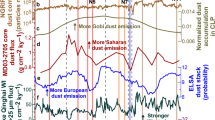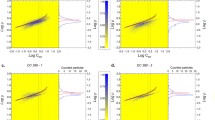Abstract.
Insoluble dust concentrations and volume-size distributions have been measured for the new 581 m deep Dome C-EPICA ice core (Antarctica). Over the 27000 years spanned by the record, microparticle measurements from 169 levels, to date, confirm evidence of the drastic decrease in bulk concentration from the Last Glacial Maximum (LGM) to the Holocene (interglacial) by a factor of more than 50 in absolute value and of about 26 in flux. Unique new features revealed by the EPICA profile include a higher dust concentration during the Antarctic Cold Reversal phase (ACR) by a factor of 2 with respect to the Holocene average. This event is followed by a well-marked minimum that appears to be concomitant with the methane peak that marks the end of the Younger Dryas in the Northern Hemisphere. Particle volume-size distributions show a mode close to 2 μm in diameter, with a slight increase from the LGM to the Holocene; the LGM/Holocene concentration ratio appears to be dependent on particle size and for diameters from 2 to 5 μm it changes from 50 to 6. Glacial samples are characterised by well-sorted particles and very uniform distributions, while the interglacial samples display a high degree of variability and dispersion. This suggests that different modes of transport prevailed during the two climatic periods with easier penetration of air masses into Antarctica in the Holocene than during Glacial times. Assuming that southern South America remained the main dust source for East Antarctica over the time period studied, the higher dust content recorded during the ACR which preceded the Younger Dryas period, represents evidence of a change in South America environmental conditions at this time. A wet period and likely mild climate in South America is suggested at circa 11.5–11.7 kyr BP corresponding to the end of the Younger Dryas. The Holocene part of the profile also shows a slight general decrease in concentration, but with increasingly large particles that may reflect gradual changes at the source.
Similar content being viewed by others
Author information
Authors and Affiliations
Additional information
Electronic Publication
Rights and permissions
About this article
Cite this article
Delmonte, .B., Petit, .J. & Maggi, .V. Glacial to Holocene implications of the new 27000-year dust record from the EPICA Dome C (East Antarctica) ice core. Climate Dynamics 18, 647–660 (2002). https://doi.org/10.1007/s00382-001-0193-9
Received:
Accepted:
Issue Date:
DOI: https://doi.org/10.1007/s00382-001-0193-9




